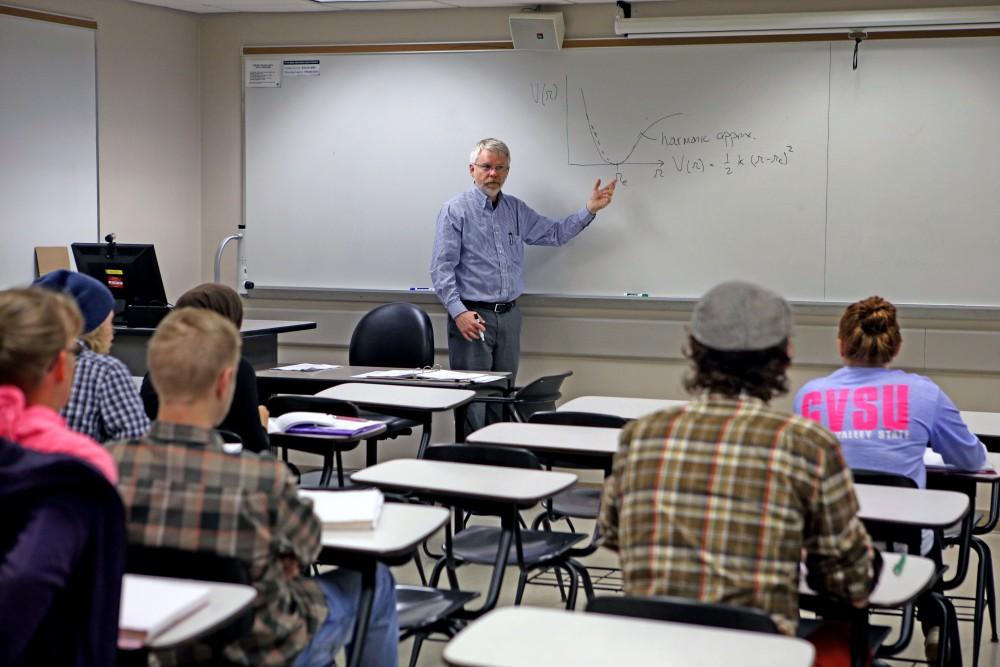GV touts largest chemistry education faculty in U.S.

GVL / Emily Frye Professor George McBane, Ph.D., begins teaching his physical chemistry class on Oct. 9th. Professor McBane is the head of the chemistry department here at Grand Valley State University and also continues to conduct outside research.
Oct 12, 2015
Devoted to studying the ways in which students learn chemistry, Grand Valley State University’s College of Liberal Arts and Sciences (CLAS) chemistry education faculty is currently the largest in the nation with five total members.
GVSU’s chemistry education department – which includes faculty members Deborah Herrington, Thomas Pentecost, Jessica VandenPlas, Nathan Barrows and Julie Henderleiter – is an emerging discipline still not practiced at many universities.
Through observations, surveys, interviews, evaluations and more, the chemistry education faculty works alongside chemistry professors in creating the most effective teaching methods within the classroom.
Frederick Antczak, CLAS dean, said the chemistry education faculty have been leaders in introducing a number of new teaching methods into the curriculum.
“Those faculty, who actively study the effectiveness of different teaching practices in chemistry, have a big influence on how their colleagues in chemistry faculty teach here at GVSU,” Antczak said. “For instance, the chemistry education faculty have been leaders in introducing clicker technology, formal small-group work in class, Process Oriented Guided Inquiry Learning (POGIL), online office hours and other recent teaching methods.”
Despite having the largest chemistry education faculty in the country, Antczak said this was not a goal GVSU had in mind. Rather, the increased amount of hiring decisions were driven by a need for instructors who could both support future high school teachers and teach introductory-level courses.
“The initial chemistry education faculty contributed so much to the department as a whole, and were so successful in other parts of their jobs including scholarly work, that the department came to regard them as one of the sub-disciplines of chemistry alongside others such as organic and analytical chemistry,” Antczak said. “As that attitude grew, chemical education was one of the options each time our department considered hiring a new faculty member.”
While Antczak described the growth of the chemistry education faculty as “rapid” in the past, he said continued expansion will depend on what demands need to be met.
“The overall department size is driven by the number of GVSU students and the fraction of them that need to take chemistry,” he said. “Since GVSU’s overall size is almost stable now, further growth will be necessary only to accommodate increases in the number of students going into STEM and health fields that require students to take chemistry.”
Aside from her research in the classroom, chemistry education faculty member Deborah Herrington also works on a research project titled Target Inquiry. In the project, Herrington assists local middle and high school science teachers with the development of their curriculum.
Herrington said this research is also beneficial to GVSU pre-service teachers looking to learn more about teaching as a profession.
“As a part of this research, the GVSU pre-service teachers get to observe a number of different middle and high school science classrooms to see how these teachers have transformed their teaching and what impact this has on their students,” Harrington said. “They also get to work with all the materials that my TI teachers develop, so they are better positioned to get a job themselves when they go to get a teaching position.”
When viewed in comparison to other schools, Herrington said GVSU has done a great job in valuing the work of the faculty in the chemistry education department.
“It’s often true that the chemistry education research faculty at other institutions have a hard time integrating with the regular chemistry faculty, and sometimes they’re not accepted as equals,” she said. “This is definitely not the case at GVSU.”

























